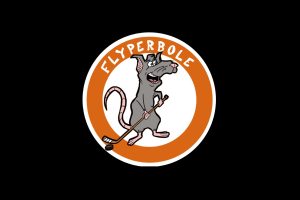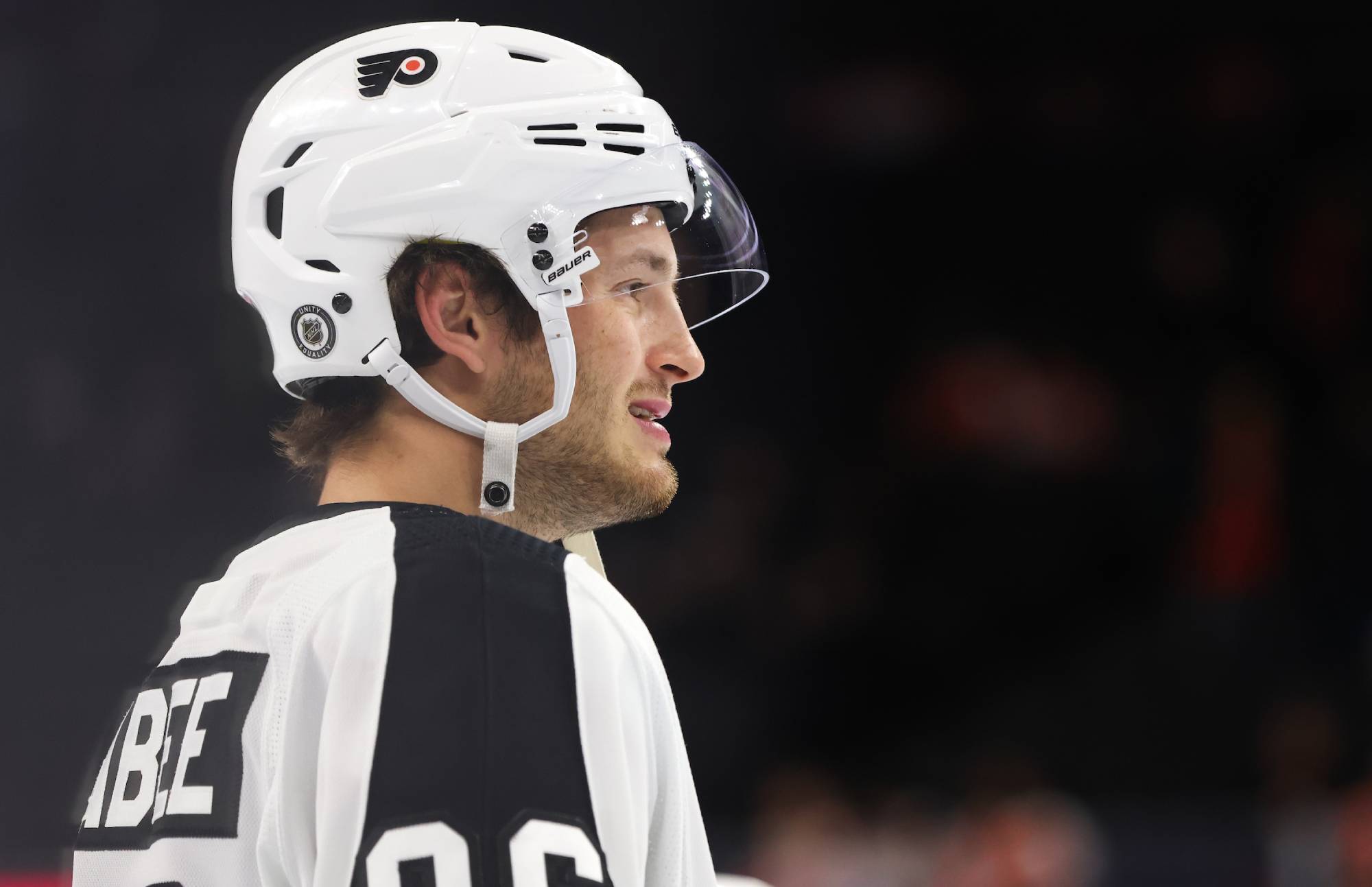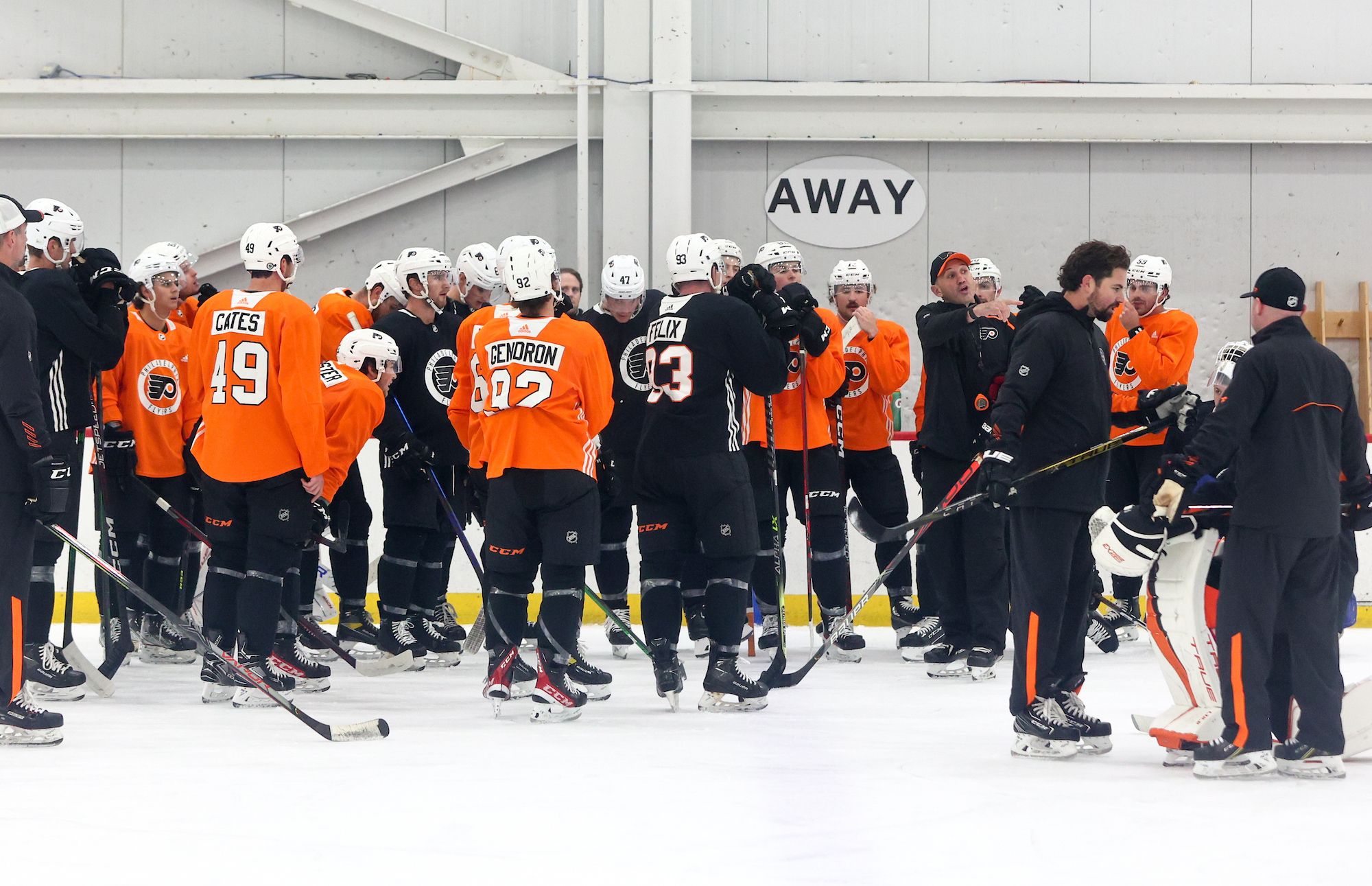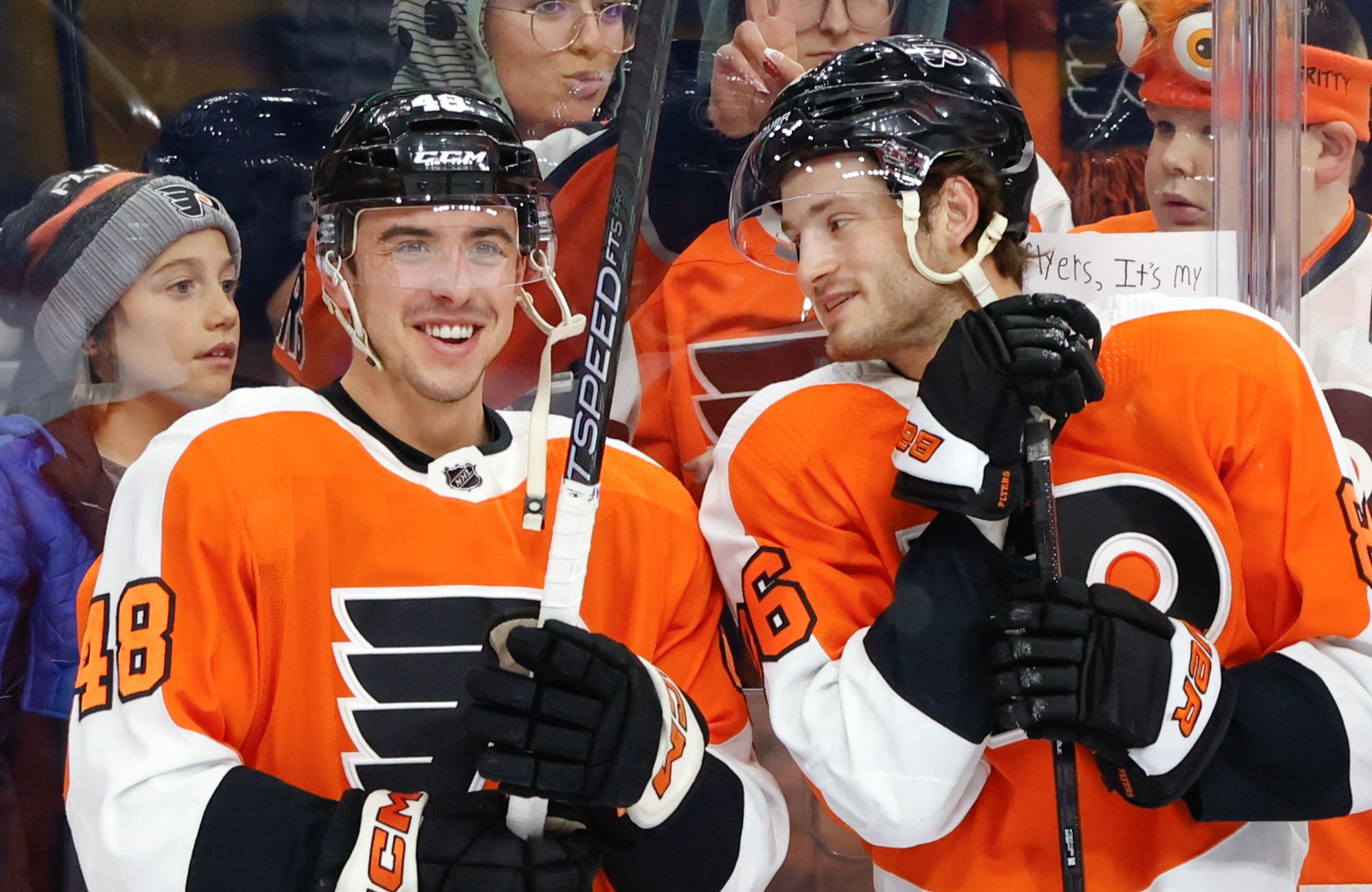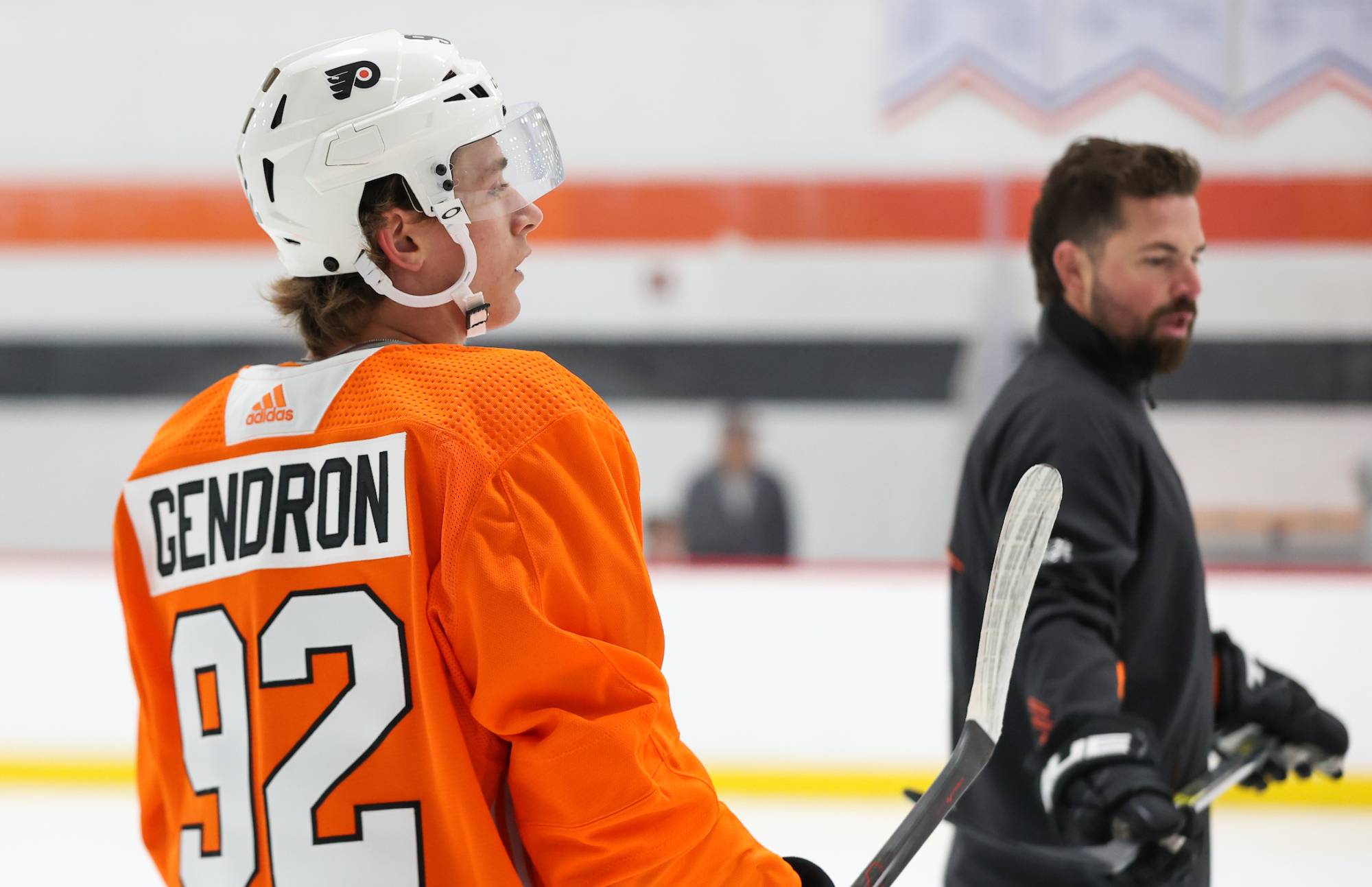Morning Observations is a feature where we break down the previous night’s game with an analytical eye.
#1: A sloppy, ridiculously entertaining game
The Flyers came away with the 3-2 victory last night courtesy of a shootout win, but despite the fact that only four actual goals were scored between the two clubs, this was far from a calm, controlled game. Instead, this felt like a game of mistakes, as both teams served up golden opportunities to their opponent on the regular. Philadelphia’s passing in the first period was particularly off, leading to a number of transition rushes by Washington, while the Caps’ defensive zone coverage was nothing short of awful during the game’s first forty minutes. But all of those mistakes led to a tightly contested, action-packed contest that will probably be remembered as one of the most purely entertaining games of the Flyers’ season.
As Shayne Gostisbehere exclaimed to a teammate in the locker room after the game: “Felt like a playoff game. Man, it was fast!” The back-and-forth style would seem to suit Washington a bit better than Philadelphia, but the Flyers hung on. They ended up behind a bit in the key 5v5 metrics, falling in score-adjusted Corsi (44.55%), Fenwick (46.76%), and xG (47.53%), but actually had a slight 3.27 – 3.09 edge in all situations Expected Goals. As most of the players on both teams noted in their respective locker rooms, this was a true toss-up game.
#2: Flyers “top” lines and Caps’ bottom lines excelled
Generally speaking, if only half of a team’s lines can deliver positive results in a game, you’d prefer it to be the lines that usually receive the most minutes from the coaching staff. For the Flyers, that formula played out last night, whereas the Capitals saw their best forward performances come from the bottom-six. Sharing the matchups against the Backstrom and Kuznetsov units, the Flyers’ lines centered by Claude Giroux and Pierre-Edouard Bellemare both delivered admirable results. Surprisingly, it was the Bellemare line (again receiving second line minutes at 5v5) that stood out most, as all three members of the line finished with score-adjusted Corsi ratings over 59%. Giroux’s line finished right around the break-even 50% mark, a solid performance against such tough competition.
On the other hand, the Capitals were carried by their third and fourth lines. The trio of Andre Burakovsky, Lars Eller and Jakub Vrana were on fire all game long, scoring both Washington goals and pasting the Flyers to a 65+ percent score-adjusted Corsi. The Caps’ fourth line (just as it did in the playoff series) also gave Philadelphia fits, and nearly were the unsung heroes of the game for Washington after Tom Wilson drew a Radko Gudas penalty at the tail end of regulation.
On the flip side, both the Philadelphia bottom-six and Washington top lines were underwater at 5v5. That seems like a trade-off the Flyers will take every time — they can deal with Travis Konecny and Wayne Simmonds not doing much offensively if it means that opponents like Alexander Ovechkin, Evgeny Kuznetsov and Nicklas Backstrom spend most of the game defending and little time creating dangerous chances.
NHL.com Report & Highlights | Corsica.Hockey Game Recap Page | HockeyStats.ca Recap | NaturalStatTrick Recap | HockeyViz.com | BSH Recap | Meltzer’s Musings
#3: Caps’ stars were basically shut down
The degree to which the Flyers were able to limit Washington’s best forwards in last night’s game was astounding. Not only did all six members of the Capitals’ top two lines finish below a 44% score-adjusted Corsi, they weren’t creating much in the way of quality chances, either. Backstrom, Oshie and Johansson were not on the ice for one Washington high-danger chance, while the Ovechkin-Kuznetsov-Williams trio could muster just one. The Great Eight himself had just four shot attempts at 5v5, and none of them hit the net.
The Capitals’ top line primarily saw the combination of Giroux, Voracek and Raffl, backed by Provorov and MacDonald. The Backstrom line, on the other hand, received heavy doses of Bellemare and company, supported by Gudas and Del Zotto. The Flyers occasionally flip-flopped the matchups, but there was a clear divide last night for Dave Hakstol between his top and bottom-six forwards, and the usage of his top two pairs versus the Manning-Gostisbehere duo. No matter which way you chop up the numbers, the Flyers won the battle of firepower vs. firepower in this one.
#4: Second period bounceback
The Flyers’ worst period of the night by far was the opening stanza. Not only did they hit the locker room down 1-0 on the scoreboard, the underlying statistics told the story of a team that was getting taken to the cleaners territorially. They posted a 32.69% score-adjusted Corsi, and were dealing with wave after wave of Washington pressure. To Philadelphia’s credit, they did look quite dangerous on the rare occasions they did get in on the attack. But that was happening far too infrequently over the contest’s first twenty minutes.
Numerous players, including Simmonds and Gostisbehere, noted that the first period hadn’t been up to their standards. Ghost specifically stated that Washington had pushed the Flyers especially hard early, and that he didn’t feel like they were expecting it. But after a talk from Hakstol (who according to Gostisbehere, essentially told the team to “wake up a little”), Philadelphia stormed out of the gate to start the second. From puck drop to the 4:25 minute mark when Michael Raffl tied the game, the Flyers racked up 11 shot attempts and allowed just two. The cycle and forecheck game was tearing apart a Capitals’ defense that had already shown signs of weakness early, and it was no surprise to see Raffl light the lamp considering the quality of the team’s play. After the Raffl goal, the Capitals stabilized, but the game would never again be as tilted in Washington’s favor as it was during the first twenty minutes.
#5: Flyers creative, Caps very poor in their own zone
It’s always tough to separate strong shot/chance creation on the part of the offense and poor structure on the part of the defense. On one hand, you have to credit the attacking team for a willingness to to get pucks into the slot and netfront areas, but on the other, it’s the defense’s job to make that task very difficult. Last night, I’d personally pin most of the blame on the Capitals’ defense.
After all, in the first period, the Flyers were not particularly sharp yet still led in high-danger chances 3-0. The gap could have easily been larger, as Philadelphia failed to generate shots on at least three other opportunities for scoring chances in the period. In the end, the Flyers racked up 22 scoring chances and eight of the high-danger variety at 5v5 last night, and were at 31 & 11 in all situations. Part of the reason for the deluge in quality shots was tactical, as the Capitals often positioned their forwards high in the offensive zone in an attempt to pressure the Philadelphia point men, leaving more space in the slot open. But just as often, it was simply poor coverage on the part of the defensemen (such as Carlson ending up in no-man’s land on Raffl’s goal) or terrible turnovers (like Kuznetsov’s on Giroux’s tally).
#6: Gudas improved after horrific first period
The Flyers’ whole plan to contain the dangerous top two lines of the Washington Capitals was based around a shared shutdown model. The Giroux and Bellemare lines would split duties versus Kuznetsov and Backstrom, while the Provorov-MacDonald and Del Zotto-Gudas pairs would do the same on the back end. The biggest hole in that plot during an underwhelming first period for the team was the play of that second pair, specifically the performance of Radko Gudas. Gudas, who has established himself as a legitimate, above-average NHL defenseman over the past season, still can regress into bad habits on occasion, such as poor defensive zone positioning and spotty passing accuracy. Both of those issues were on display in the first twenty minutes, and it culminated with a shot block attempt on Burakovsky’s first goal that looked more like he was a schoolchild doing air raid drills during the Battle of Britain.
But credit Hakstol for not abandoning the plan. Instead, he kept using the Del Zotto-Gudas pair in tough minutes, and eventually, Gudas figured things out. By the conclusion of the game, the Czech defenseman led his positional counterparts both in score-adjusted Corsi (49.83%) and in xG (65.78%). Unsurprisingly, he succeeded by simplifying his game, making quick, easy passes and using his “fire from everywhere” style in the offensive zone to help generate havoc in front of the net. It’s truly reassuring that Gudas was capable of righting the ship after such a poor start, against such a strong opponent.
#7: Stellar sequence by Giroux on his goal
It’s easy to look at Claude Giroux’s late second period goal and chalk a large portion of it up to luck. After all, he was essentially gifted the puck by Evgeny Kuznetsov with tons of space in the high slot prior to sniping it past Braden Holtby. But there are two problems with that narrative. First, the shot itself was ridiculous — a far-side, top corner rip that looked essentially unstoppable. Second, and just as important, Giroux was the only reason the play got into the offensive zone in the first place.
To begin the sequence, Giroux sprung Ivan Provorov with a cross-ice stretch pass originating from the defensive zone that sent the rookie in on a semi-breakaway. Holtby came up with the big save, but Giroux alertly trailed the play, and as a result, ended up in the perfect position to pick off Kuznetsov’s errant pass and then bury it seconds later.
#8: Power play was legitimately awful
I’ve often defended the Flyers’ power play on nights when they couldn’t break through with a goal but racked up shots and scoring chances. In those games, the process was sound but the results just weren’t there — nothing to worry about over the long-term. Last night was not one of those nights, however. In two opportunities with the man advantage, the Flyers’ top unit could manage just a 49.18 Corsi For per 60 — an awful shot generation rate even at 5v5. The second unit was even worse, as they couldn’t even manage a single weak shot attempt.
So what was the issue? Just as they did in the playoffs, Philadelphia definitely struggled with Washington’s aggressive defensive zone play, which is high-risk but can serve to completely shut down talented power plays. The biggest issue, however, was the Capitals’ ability to control the puck for extended periods of time. When they forced turnovers in their own zone, Washington regularly elected to carry the puck out rather than mindlessly clearing it down the length of the ice. The Flyers’ pursuit was tentative, resulting in the Capitals being able to waste significant portions of the PP far away from their own net. It was stellar penalty killing, but also uncharacteristically lethargic play on the part of Philadelphia.
#9: Lyubimov unreal on the forecheck
I’m not sold that Roman Lyubimov will ever be even a decent scorer at the NHL level. He didn’t add much offense in the KHL, and he doesn’t exactly seem like a creative passer, at least from what he’s shown thus far in a Flyers uniform. But what Lyubimov does bring to the table is some of the most relentless forechecking I’ve ever seen from a hockey player, combined with top-notch technique.
Just being fast and aggressive isn’t enough to be an above-average forechecker. After all, Zac Rinaldo had both of those characteristics in spades, yet he never drove play at 5v5. Lyubimov doesn’t just get to the corners and hit the guy with the puck — he actually separates him from it, using a combination of strength, leverage, and an inherent understanding of angles to cut off defensemen in puck pursuit. Going into last night’s game, Lyubimov was just barely negative in terms of CorsiFor%RelTM at -0.8%, despite receiving the bulk of his minutes alongside possession drags Bellemare and VandeVelde.
He very might have pushed that back above water today, as he posted a strong 59.79% Corsi For last night, finishing +24.09% relative to his teammates. When it comes down to it, Lyubimov is basically the perfect fourth liner for Dave Hakstol — an uncomplicated, north/south forward who wins puck battles and flourishes on the cycle. But unlike Bellemare and VandeVelde, it’s looking like Lyubimov may actually be able to deliver positive play-driving results on a regular basis.
#10: Gostisbehere had a “bad result” game, but process seemed fine to me
There’s no getting around it — Shayne Gostisbehere did not have his best game last night. Despite primarily facing the third and fourth lines of the Capitals, Ghost posted a defense-low 39.56% score-adjusted Corsi For percentage and an also-poor 38.36% xG. The eye test wasn’t kind to him, either. He struggled with turnovers, got burnt a few times in the neutral zone on rush coverage, and even passed up a golden opportunity in the slot to attempt a (failed) feed to Giroux. It was a game to forget for Gostisbehere.
But while all of these plays certainly qualified as errors, in my mind, none were necessarily the product of a flawed thought process — they were simply physical mistakes. This is where I differ from many in terms of how I evaluate defensemen. For me, Shayne Gostisbehere’s skillset is close to ideal, in that what he is good at (tight neutral zone coverage, puck carrying, passing) is what I view as truly essential to being a successful NHL defenseman, and his areas of weakness (puck battles, defensive zone coverage) are areas that I see as helpful but ultimately overrated on the whole. To be truly elite, you have to be above-average in most areas, but I believe that a defenseman strong in the former set of skills but lacking in the latter will ultimately be more effective than the reverse.
As a result, if I see Gostisbehere turn the puck over on a controlled zone exit attempt, I don’t view it as an egregious mistake. Sure, it hurts in the moment. But the offense that Ghost generates by consistently trying to move the puck up ice with control versus regular chip outs to the neutral zone will (over the long-term) outweigh the short-term hit of the occasional memorable turnover. Some goes for neutral zone coverage — sometimes, Ghost will get burned and cause an odd-man rush due to his aggressiveness. But that’s the cost of doing business with a defenseman who breaks up entries regularly, which almost always sends play back the other way.
Even his “ill-advised” pass to Giroux wasn’t as awful of a process as it seemed at the time. Through tracking research, we know that rushes containing multiple passes moving through dangerous areas have a higher shooting percentage than a normal “rush-and-shoot” play. Sure, Ghost was in a great spot to shoot on that play last night, and maybe he would have scored. But from my vantage point in the press box, it sure seemed like if Gostisbehere’s pass was on target, Giroux would have been looking at a wide-open net. Like the turnover behind the net and the neutral zone rushes, this was more of a physical mistake (a poor pass) than an awful decision. It’s my belief that if Gostisbehere is simply allowed to trust his natural creativity on the ice, he’ll be an extremely productive player for the Flyers in the coming years. Last night, the results weren’t there. But I still saw a player trusting his instincts, and as a result I came away unconcerned.




